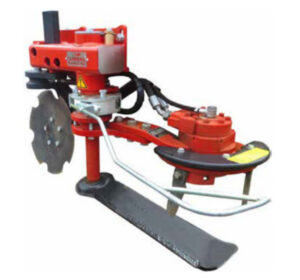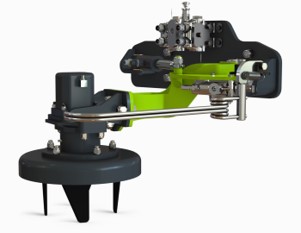Background
Several different tools are used by wine-grape growers across Australia to manage undervine weeds without chemicals. Most growers use a combination of equipment to achieve good weed control.
Cultivation is commonly used for non-chemical weed control, with the rotary tiller (Figures 1 and 2) suited for times when greater soil disturbance is required.

Figure 1. Clemens knife weeder with rotary tiller and disc plough attachments (image courtesy of Clemens)

Figure 2. FMR rotary tiller (image courtesy of FMR)
Action
Powered rotary tillers have vertical tines fitted to a rotating head which is hydraulically driven. They divide or break up clods and previously turned over root mat. This tool disturbs weeds along the edge of the undervine area without mounding up the soil undervine. Powered tillers are normally used in conjunction with other tools such as a knife weeder or disc plough.
Advantages and disadvantages
Advantages: A powered rotary tiller is robust and has a fast-operating speed, it reduces competition from weeds, provides longer-term weed control and requires low operator skill.
Weeds that are tightly bound to soil can be difficult to dislodge with less aggressive undervine weeders such as a finger weeder, knife weeder, a draft disc plough or a draft rotary tiller. A powered rotary tiller can be used in conjunction with these tools to dislodge weeds and reduce the risk of transplanting.
Disadvantages: Powered rotary tillers may spread couch and kikuyu and may be difficult to use as a stand-alone tool in hard compacted ground. Soil structural damage will occur if used in unsuitable conditions.
Undervine cultivation can cause reductions in vine vigour in the first two years until the vine roots adjust by moving deeper into the soil profile.
Table 1. Advantages and disadvantages of a rotary tiller
| Ability to reduce weed competition with vines | Good |
| Soil disturbance caused | High |
| Suitability in young vineyards | Poor |
| Length of weed control | Good |
| Operating speed | Average |
| Operating cost | Average |
| Capital cost | Poor |
Considerations
When considering which weed control tools to use, it is important to base the decision on each vineyard’s individual characteristics. Factors such as soil type and condition, slope, rainfall and water availability, weed type and pressure, vine age, vine vigour, fruit end-use targets, weather conditions, and compatibility with existing infrastructure and equipment should all be considered.
Table 2. Ease of using a rotary tiller on different soil types
| Large or excessive stones | Difficult |
| Stone/gravel | Difficult |
| Sand | Easy |
| Silt/loam | Easy |
| Clay | Moderate* |
*Can be difficult in wet or very dry soils
Cultivation tips
- Control weeds when they are small.
- Any cultivation operation is most effective in hot, dry weather with dry soils.
- Multiple passes may be required if the soils are heavily compacted.
- Using a rotary tiller in combination with another cultivation tools such as a disc plough, knife weeder or finger weeder may be beneficial.
- Cultivation may be difficult in very wet or very dry conditions.
Resources
Organic Winegrowers New Zealand. 2017. Undervine weed management – A practical guide to effective weed control in organic vineyards.
FMR undervine tiller head with sensor
Contact
For further information, please contact:
AWRI helpdesk
Phone 08 8313 6600 Email helpdesk@awri.com.au

